American Chestnut Revival
Restore the Crown of Abundance
THURSDAY AUGUST 7, LOUIS MAY, an elder environmentalist in the upper Hudson Valley, drove me 70 miles to see a tree he has watched and measured for 35 years. Lou’s tree is in dense forest on a steep slope at the south end of Schoharie Valley. Its 18-inch dbh trunk isn’t impressive for that forest. Actually, it’s a midget compared to its mighty ancestors—but these days, any American Chestnut is rare. This one is a giant and an elder.
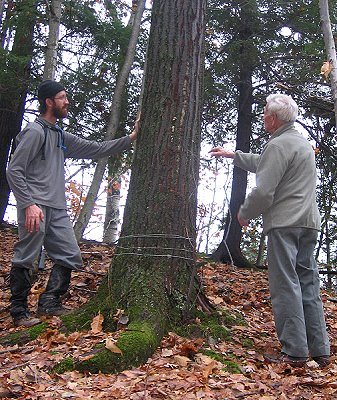 If uncommon today, a century ago, the American Chestnut was among the most abundant species and largest tree in Eastern Woodlands. A stout trunk with wide-spreading crown of limbs yielded an annual crop of nuts in spiny fruits. Many forest creatures ate sweet nutmeats of this generous giant. A common tale tells that squirrels traveled from Georgia to Maine jumping from chestnut to chestnut.
If uncommon today, a century ago, the American Chestnut was among the most abundant species and largest tree in Eastern Woodlands. A stout trunk with wide-spreading crown of limbs yielded an annual crop of nuts in spiny fruits. Many forest creatures ate sweet nutmeats of this generous giant. A common tale tells that squirrels traveled from Georgia to Maine jumping from chestnut to chestnut.
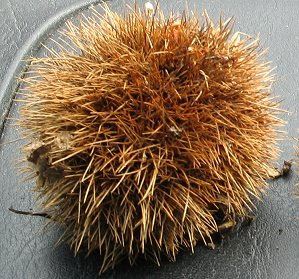 The impetus for our journey wasn’t admiration or food. Lou wanted my advice on a fungus growing 25 feet up the downhill side of the trunk. The tree is in a medical emergency, with dire need of botanical intensive care. And though the tree has blossoms and fruit, its seeds are infertile.
The impetus for our journey wasn’t admiration or food. Lou wanted my advice on a fungus growing 25 feet up the downhill side of the trunk. The tree is in a medical emergency, with dire need of botanical intensive care. And though the tree has blossoms and fruit, its seeds are infertile.
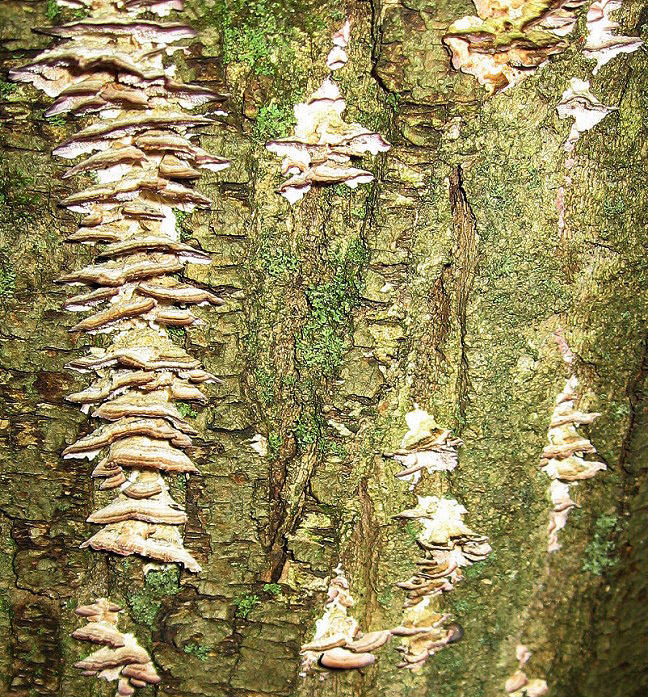 My intuitive method told me the tree is 85 feet tall, an amazing 88 years old. So, the tallest chestnut I’ve ever seen sprouted from seed in 1920—same year chestnut blight appeared at NY Botanical Garden, imported from China. The orange fungus spread like wildfire in wind. By 1940, nearly every American Chestnut from Maine to Georgia was dead, or pruned to a sprouting stump. In two decades, a species was pushed to the edge of extinction, where today it still hovers like a ghost.
My intuitive method told me the tree is 85 feet tall, an amazing 88 years old. So, the tallest chestnut I’ve ever seen sprouted from seed in 1920—same year chestnut blight appeared at NY Botanical Garden, imported from China. The orange fungus spread like wildfire in wind. By 1940, nearly every American Chestnut from Maine to Georgia was dead, or pruned to a sprouting stump. In two decades, a species was pushed to the edge of extinction, where today it still hovers like a ghost.
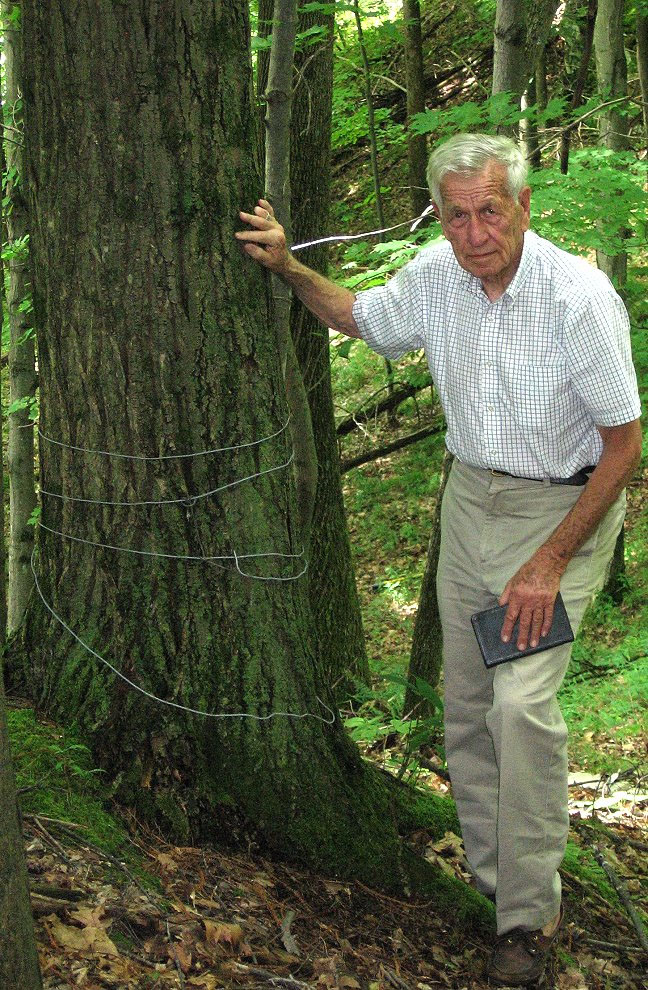
Lou’s 88-year old chestnut isn’t infected by the aggressive blight, but invading fungus has already reduced sap flow to the crown. Leaves were sparse in the canopy, as knee-high buds sprouted from the root bulge. I decided not to evaluate the tree’s odds to survive this advanced infection, and just do what we can.
I sat on the tree’s doorstep, and asked what it needs to defeat the fungus and produce fertile seeds. Answers entered my mind. I translated to Lou, who agreed to immediately apply the remedies. To my chemistry-trained brain, the answers were—“Calcium, Phosphorus, Trace Elements.”
In my agricultural experience, this begins with limestone, rock phosphate, sea minerals.
Calcium: primary alkaline electric charge in cells, rapidly lost in soil washed by steady acid rains. Sweetness—the sugar cycle —depends on calcium alkaline energy, so we store it in our bones. Today, osteoporosis afflicts both our bodies and our soils.
Phosphorus – limiting element in Northeast soils – an ion to carry negative charge inside a cell, and every active growing tip – root, bud, flower, fruit, seed.
Trace Elements: Least understood are the least of all—the “trace” elements. A few are known to be needed at parts per million, but many more are essential at parts per billion (nano-elements), some at parts per trillion (pico-elements)—current limit of detection by laboratory assay. Many aren’t metabolized by plants, but by specialized bacteria. These heavy elements provide extra density and complex orbital geometries Nature needs to build large, elaborate, biological molecules, such as enzymes, hormones, membranes, DNA.
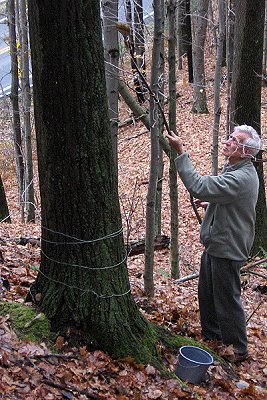
I explained to Lou how every year, a chestnut must grow a huge, thick crown of very large leaves, plus a big crop of fruits, each with several nuts. This is massive task is a tight timetable. Each spring, each tremendous tree must mobilize an immense mass of minerals and other nutrients up from the soil. Every new year, this spring feeding frenzy dissolves minerals into water, then sends them up to the crown to nurse newly unfurling leaf and flower buds. This immense task requires help from a complex underground community—the soil food web—symbiotic microbes that transform geology into biology—mineral into protoplasm—soil into tree.
The chestnut’s health and survival depend on our success to re-create a complex, high density microbial community—the tree’s supporting soil food web. I wondered if increasing acid air pollution from early industry caused to sharp declines in soil life, eroding this supporting symbiosis, weakening the entire species, assuring easy invasion by an Asian parasite. I learned decades ago soil nutrition isn’t in the mindset or toolbox of scientists trying to restore this endangered species.
However, fungus under the bark is an acute, immediate threat. This advanced invasion can’t wait months for minerals to soak into soil to be digested by microbes, then fed to tree roots to make the trip up through vascular tissue to where infection is spreading. Direct, immediate application is needed. So, I told Lou to saturate the bark with a dilute sea mineral solution. Since Lou lacks a portable sprayer, he would use a brush to paint the solution on.
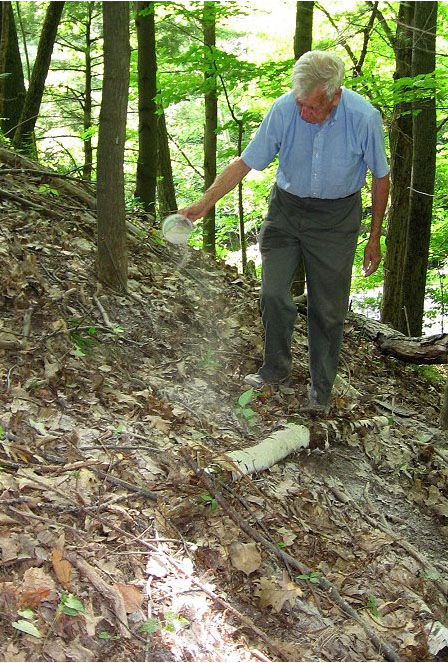 Back at my house, I gave Lou small bags of three materials to get started. Lou returned straight to the tree to paint the trunk and exposed roots with sea mineral solution: 5 tablespoons per gallon, brushed on every exposed tree surface in reach. Lou scattered his remaining sea minerals, with limestone and rock phosphate, above the roots—and realized he’ll need much more mineral dust to feed one tree in a forest.
Back at my house, I gave Lou small bags of three materials to get started. Lou returned straight to the tree to paint the trunk and exposed roots with sea mineral solution: 5 tablespoons per gallon, brushed on every exposed tree surface in reach. Lou scattered his remaining sea minerals, with limestone and rock phosphate, above the roots—and realized he’ll need much more mineral dust to feed one tree in a forest.
Next day, as I left for the Northeast Organic Farming conference, Lou called to get more minerals to feed his tree. I left on a 2-week teaching trek in New England excited Lou is taking direct, immediate action to save his endangered tree—and maybe boost hope for its family.
Earth and Nature need millions of men like Lou.
THREE WEEKS LATER – LABOR DAY – Lou took me on a second 140-mile trip – a check-up visit to his tree. Again awed by the tree’s size and age, impressed by Lou’s diligent care – and rapid response to treatment by the fungal infection.
Fungal blooms were already turning brown, shrinking—in seeming retreat—but really, only on the surface. The light alkaline drench with dilute sea mineral solution upsets acid-driven fungal metabolism. I wished we could make a stronger application, but would risk pH shock to soil ecology at the tree’s base. So, several light, dilute washes, rather than one large, harsh, heavy dose.
Most fungal growth is under the bark, where it slowly encircles the trunk, clogs sap flow, and strangles the crown—killing the tree. This fungal growth is already extensive—over 20 feet up the trunk—but seems confined to downhill. Uphill, at the doorway, seems open, clear, functional.
Two full years are needed to defeat the large fungal mass—before the parasite hidden under bark stops growing. Longer to regenerate damaged vascular tissue, reconnect root and crown, regrow a strong, healthy crown.
Lou methodically painted the tree with sea mineral solution a fourth time. His bristle brush saturated every exposed surface—even mossy roots snaking downhill.
Then, all over the tree’s feeder root zone, we scattered 20 lbs. of a blend of four rock powders, plus two cups of sea minerals:
Rock Phosphate—sea sediment, phosphorus rich, Florida
AZOMITE™—ancient sea floor clay sediment with trace elements, Utah
Planters 2™ – fossil mineral spring deposit, calcium sulfate with trace elements, Salida Colorado
Traprock – igneous basalt; dense, paramagnetic, primary crystal with trace elements, Amherst Massachusetts.
AZOMITE™ provides sea minerals with trace elements as an insoluble clay hydrate. Planters 2™ supplies calcium and trace elements without raising pH. Dense paramagnetic traprock crystals boost geometric coherence to increase cellular bandwidth. All add ample amounts of the least of all the elements—the trace elements—needed in such tiny amounts, yet so critical to nature’s most complex intelligent functions—membrane, immunity, DNA, and reproduction.
Finely ground stonemeal (200-400 mesh) is, first of all, food for microbes. Primary elements are rapidly digested by bacteria and fungi in soil, who share nourishment with the entire, wider food web. This food-sharing network is currently in shock in most soils – semi-starved from decades of increasingly acid rain. Rock powder is a natural remedy for osteoporosis of soil and soul.
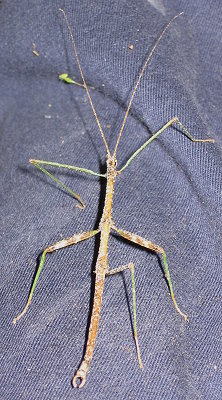
After spreading the rock powders, I noticed a bizarre-looking insect—a 6-inch, 5-legged walkingstick climbed up my pant leg. I greeted the appearance of this odd-looking creature as an ambassador with a message from the natural community thanking us for improving the neighborhood.
Results are already evident from Lou’s sea mineral treatments on the trunk. My hope the tree can recover and regenerate is encouraged. But I know how quick fungal infection can choke off a tree—and this is already an advanced case. In such a worst case outcome, the roots will survive, and sprout new shoots, but it would be sad to lose an 88-year-old crown.
However, we are limited by what we can achieve this year. At summer’s end, tree metabolism is slowing into dormancy, growth is declining and turning inward to form buds of next year’s leaves and flowers. The powdered rocks minerals we broadcast have barely begun to filter down into the root zone. More than a few weeks are needed for those rock minerals to be digested and dissolved into bio-available nutrients, and then be sucked up by the tree as sap to feed buds in the crown. A full growing year is needed for rock powders and sea minerals to be delivered by the soil food web to tree roots.
Next spring—2009—a rich supply of elements will rise as sap to stop the fungal invasion, and higher, to feed emerging buds to grow new canopy.
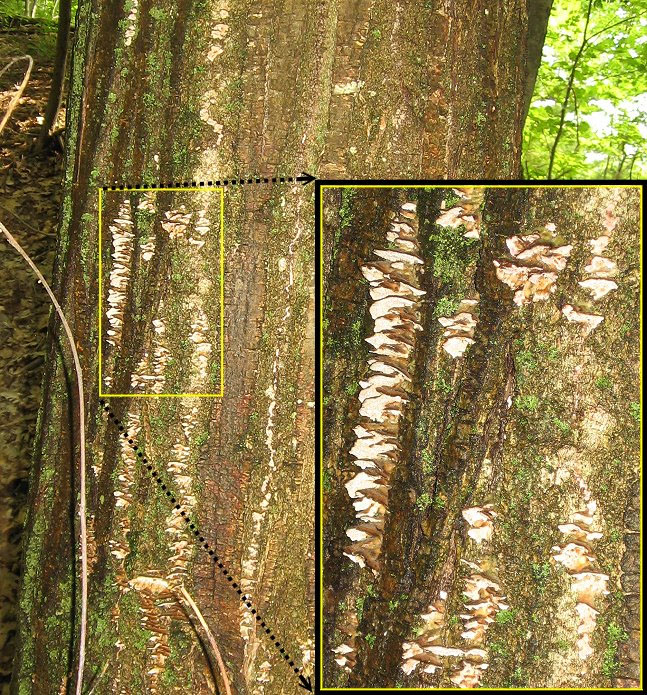 And next spring, we will have to shift strategy as the treatment progresses and conditions change. Fish emulsion and liquid sea weed are nutritional tools to spray on tree bark to fight the fungus head-on. I will investigate if we can brew anti-fungal biologicals in home-made batches of compost tea. A bit of sugar sprayed on soil might activate the no-see-ums.
And next spring, we will have to shift strategy as the treatment progresses and conditions change. Fish emulsion and liquid sea weed are nutritional tools to spray on tree bark to fight the fungus head-on. I will investigate if we can brew anti-fungal biologicals in home-made batches of compost tea. A bit of sugar sprayed on soil might activate the no-see-ums.
Perhaps the second spring from now—2010—will see the tree sprout a full crown of leaves and flowers again. And that summer, perhaps, bear fertile seeds.
FRIDAY, NOVEMBER 7, 2008, Lou took me on my third visit to his extra-ordinary chestnut. My first visit was three months earlier. Now, I could assess effects of Lou’s mineral washes.
We took along Fred Breglia, head of horticulture at Landis Arboretum, and team leader of eastern NY ancient forest survey. The biggest American Chestnut Fred ever saw was only 7-inch dbh—hardly 1/3 this tree. Fred was amazed by Lou’s foot-long chestnut leaves pressed between cardboard in his car.
After a short hike around a guard rail and up off the road, then steeply into the forest, soon we again stood on a steep slant below a remarkable18-inch dbh American Chestnut.
Lou went right to work painting the trunk, while I scrambled up, around and down taking photos. Lou had a pole to extend his reach farther up the grooves bulging with fungal shells. Lightly alkaline, full spectrum sea minerals strengthen the tree, weaken fungus. A full toolbox of nano- and pico-elements fully arms membrane-DNA integrity for strong cellular immunity.
I examined fungus on the tree, uncertain what to look for, or how to interpret what I saw. Lou had already soaked the trunk, further confounding my inspection and analysis. Yet, only one 12-inch split in the bark showed new, white fungal growth.
Most older fungi had a bizarre purple & pink color—with a faint luminance—like a low frequency, infra-red radiation.
I’m satisfied fungal blooms sprouting through bark surface are still declining. The lightly alkaline, full spectrum sea mineral drench seems effective to strengthen the tree and weaken fungus. I imagine the tree absorbing precious trace elements through its bark. If fungus can grow out through such tough skin, sea minerals can get sucked right in.
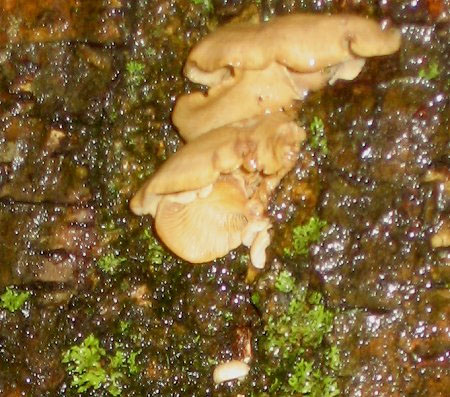 Next time, I’ll bring my backpack sprayer to saturate the trunk as high as it can spray. Lou’s paint brush is puny compared to an 18-inch dbh forest tree, but has gotten the job done.
Next time, I’ll bring my backpack sprayer to saturate the trunk as high as it can spray. Lou’s paint brush is puny compared to an 18-inch dbh forest tree, but has gotten the job done.
Lou and I scattered another 20-pound rock dust mix above feeder roots. This blend included greenstone (dense, igneous, primary crystal). When trees, herbs and seeds wake up early next spring, soil microbes will have a rich feast ready for them. The hillside will sprout vibrant green—both ferns in the hollow, and canopy high overhead will grow thicker, denser, darker.
While Lou and I ministered to the tree, Fred power-hiked up the steep mountain to look for more chestnut trees. Pollen from another tree is needed to cross-fertilize Lou’s tree. There must be more chestnuts nearby, although none were in sight in the immediate area. My intuition questioning had determined there were more chestnuts a few hundred feet up, near the mountaintop.
Regrettably, Fred returned to report he found no other chestnuts on upper slopes, and the hilltop just a few feet beyond the summit was logged a few years ago.
 We talked over the tree’s weak condition. The crown is dying—mostly dead. Fungus has nearly girdled the trunk, but still mostly confined to the north face. The crown was declining for a few years, with large limbs already broken off. Next year may have been too late.
We talked over the tree’s weak condition. The crown is dying—mostly dead. Fungus has nearly girdled the trunk, but still mostly confined to the north face. The crown was declining for a few years, with large limbs already broken off. Next year may have been too late.
But new leaves are sprouting at the tree’s core—along the trunk, limbs and larger branches. The tree is struggling to regenerate a leafy crown and continue capturing sunshine into sugar. But this is a close race between decay and growth. Soil nutrition with full spectrum sea minerals will win—eventually. The tree is dangerously weak with advanced infection. The crown may die.
Two years (one full growing season) are needed to address the tree’s condition, and process new minerals we add to soil into truly healthy growth by Lou’s threatened patient. For the next 18 months, this endangered chestnut will remain in acute care.
Our last task before we left was to adjust the “French coil” that Lou had attempted to wrap around the base of the trunk. I had located the tree’s “doorway” on my first visit. Now, I located the top and bottom of the doorway, and we realigned the wire coil as best we could without any fasteners. My goal was to form a smooth, even-spaced coil around the doorway, and encourage a trickle of electric charge to initiate an upward spiral circuit.
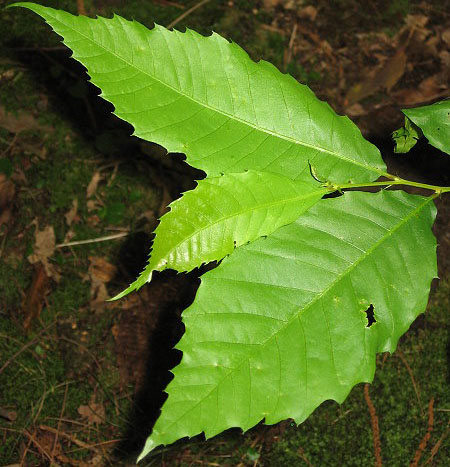 However, we had no way to precisely fix the wire to the trunk, and the wire was soft, gray metal, not copper or similar high efficiency conductor. Considering fungus has invaded much of the vascular tubes on the opposite side of the tree, I felt an urgency to install an effective French coil to help sustain the tree’s primary energy circuit. Next visit, I will bring copper wire and fasteners to improve the effectiveness of the French coil. Before next spring’s growth begins, I’ll properly wire a patch around the tree’s primary growth spiral.
However, we had no way to precisely fix the wire to the trunk, and the wire was soft, gray metal, not copper or similar high efficiency conductor. Considering fungus has invaded much of the vascular tubes on the opposite side of the tree, I felt an urgency to install an effective French coil to help sustain the tree’s primary energy circuit. Next visit, I will bring copper wire and fasteners to improve the effectiveness of the French coil. Before next spring’s growth begins, I’ll properly wire a patch around the tree’s primary growth spiral.
We agreed to visit the tree before winter, for a final alkaline coating on the bark. If possible, we will make a more methodical survey upslope to find the other members of this tree’s family. It simply cannot be the only specimen around. The nut it sprouted from couldn’t have rolled too far downhill. Its mother and her family must be somewhere nearby—perhaps surviving as sprouting stumps in this protected forest.
We agreed next spring to hold a “sex party” during Chestnut blossom. I imagine cheering the tree into ecstacy with music and meditation. Drum and flute are ancient instruments of celebration and seduction. Maybe sing a few bawdy songs. Ceremonial dance around the tree is impossible with extreme slope and fragile soil.
Lou is quite determined about assuring proper fertility. H insisted if necessary he will carry pollen to the tree. I bow to the great love that empowers this quiet, thoughtful man to do whatever helps this majestic survivor recover from its fungal infection, and produce fertile seed.
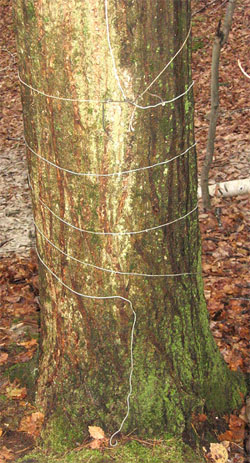 We won’t know until late spring, when the new leaf canopy unfurls, how well our soil feeding program is succeeding. I can’t hold my breath that long, but my fingers and toes are all crossed.
We won’t know until late spring, when the new leaf canopy unfurls, how well our soil feeding program is succeeding. I can’t hold my breath that long, but my fingers and toes are all crossed.
While watching the election, I uploaded lots of articles, technical reports, fact sheets, photos, and weblinks to the website: Carbon Negative Food and Fuel
Please check out this new resource; send me any feedback and suggestions you have.
For a green & peaceful planet,
David Yarrow
Turtle EyeLand Sanctuary
44 Gilligan Rd, East Greenbush, NY 12061
skype: david.yarrow5
cell: 518-881-6632
www.championtrees.org
www.OnondagaLakePeaceFestival.org
www.farmandfood.org
www.SeaAgri.com
Support us on Patreon
Thank you for joining us today! Please become a member of RTE and support us on Patreon. Unlike many larger organizations, we work with a team of determined and passionate volunteers to get our message out. We aim to continue to increase the awareness of remineralization to initiate projects across the globe that remineralize soils, grow nutrient dense food, regenerate our forests’ and stabilize the climate – with your help! If you can, please support us on a monthly basis from just $2, rest assured that you are making a big impact every single month in support of our mission. Thank you!







John Carraway
October 12, 2011 (7:49 pm)
The use of sea water seems to be the wave of the future. May I suggest you mix a lot of sea plants and whole lemons with sea water in a blender and pour several jars of the stuff around the tree. You’ve given the tree calcium, phosphorous, and trace minerals, but I think it needs sulfur(MSM), iodine, niacin, and selenium also. Add those to the blender, as well as anything else that may be beneficial, such as SBO’s and certain root-enhancing mushrooms. Maybe you should drill small holes around the tree to better reach the roots. And don’t forget fulvic and humic acids, as well as more B vitamins. You might want to add some baking soda to your bark emulsion as well. Let me know if any of this sounds feasible, or is it off the wall.
Kathrin Bateman
May 27, 2018 (7:24 pm)
A friend noted that he remembered hearing somewhere of a man use through radionics determined that the rapid spread and devastation of Chestnut blight and Dutch Elm Disease were caused by Iodine deficiency so the previous comment that mentions that had me perking up my ears…..or would that be perking up my eyes? Love the care and generous hearts caring for this tree.
Joanna Campe
June 6, 2018 (1:41 pm)
Hi Kathrin,
Glad to see you here! Very interesting theory about the devastation of Chestnut blight and Dutch Elm Disease! I feel certain that remineralization would insure their strength and health into the future along with other possible treatments.
Joanna at RTE
Llama
May 9, 2019 (3:15 am)
I’ve been doing this to some sycamore trees around my house that were suffering from anthracnose. So far it is working.
Joanna Campe
May 11, 2019 (12:40 am)
Hi Llama , please consider writing up something for us about your experience that we could report on in the future. Thanks! Joanna at RTE